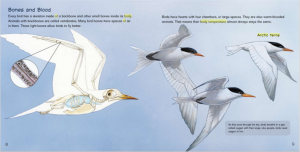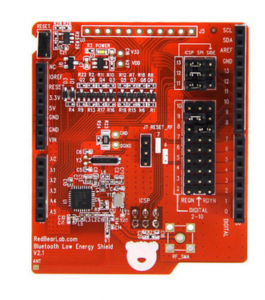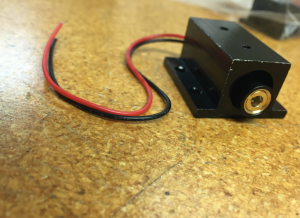In this weeks meeting Charlie started things off with laying out what questions we still had for Oli such as dates for the trip, in what location, and where would we be staying. We also discussed the logistics of the Xsede conference and the likely-hood of needing to fly directly from Iceland to Miami. On a side note, the idea of a Wilderness type program at Earlham was brought up. Our next topic was brought up by Erin, that we might have some issues with the balloon idea but that running the balloon off of a telephone pole might be the better option. Ben detailed what he had found regarding the thermal camera and that will start on a way to map the data and logistics of using it. Nic annotated a page on android dev explaining how processes work and when to use them, as well as possible implementations of old Sheshat code into the FieldDay app. Deeksha went over requirements for the SIGCSE poster. Kristin has been working with the LightBlueBean, figuring out the interface enough to get a test up and running and has been working with Charlie and Nic with the design and implementation of FieldDay app. Tara has been doing work with the sensors and has been working with Mike Deibel on soil fertility and found we might be bale to build an equivalent to a near IR spectroscopy. The Munsel colour test is definitely viable for use with visible light. Eamon started doing work with the front end and getting google maps to geolocate points and the Drop menus are finished and easily useable.
BLE shield and laser diodes have arrived! New options for fertility spectrophotometry.
BLE Shield
The Makershed BLE shield I ordered arrived this week! My plan right now is to use this shield on the temperature/moisture sensor designed for use in the field. The field sensor will look a lot like soil platforms we have used in the past with the addition of an IR sensor for measuring temperature of the soil. I have ordered a small IR sensor that I am expecting to arrive soon. To test it’s accuracy I will use a fluke IR thermometer as a benchmark.
I am pretty new to Arduino development so I have been reading up on how to interface a BLE shield with an android application. I downloaded the BLE libraries for Arduino. Now I am trying to think about how my sensor will interface with Field day. I want a reading to come up on the screen as it is taken so that the user can confirm data is being recorded in the app.
The next thing to consider is the casing for the platform. I think the 3D printed ‘flask’ idea from the first Iceland trips is pretty solid and I would like to do something like that again. I would also like to case the outside of a plastic case with rubber to make the flask more impact resistant if it is dropped.
Laser Diode
The laser diodes arrived this week. I will begin prototyping the optical density sensing rig this week in lego.
Spectrophotometry
There are some interesting commercial solutions for near IR component analysis. One is the Scio – a kick starter project that has now gone into production. The Scio goes into the near IR range and comes with a developer SDK that would allow us to test it on soil and interpret the spectral results based on known soil composition and Mike Deibel’s more advanced IR sensors. There is another option called Tellspec but it seems much more closed-source.
Imaging from the Top of Campus
We did lots more testing with the Fluke Thermal imaging camera. We tested various objects and different distances in the building, including down the Stanley hall which proved even more difficult (most likely because the lighting makes the hall warmer and we were just detecting our cell phones). From the roof of Dennis we played around with manual settings and tried detecting different things (mostly other people). It works well! The battery also lasted the whole time we were up there. Next we can look at something that is the same size and temperature as the birds we will be looking at. One idea is to microwave water in bottle to the temperature we want because that can be consistently replicated and we can know what the temperature should be. Another idea is to use the camera to look at some squirrels on campus which might be good for testing small, moving objects.
Oli emailed Charlie back with answers to our questions from earlier. The two species that we will be surveying are the Arctic Terns and the Eiders (waterfowl). I sent Bernard an email asking him if we should also put energy into surveying the Limosa limosa which is vulnerable to loss of breeding sites. In the email I sent I also asked if he thought there were any other species that might be worth surveying. The Eider is a larger duck-like bird that is fairly common in Iceland and used for down. Apparently they are all around Skalanes. I have read some papers on them, but I need some more information about where exactly in Skalanes. Are they near domesticated? Because if they are using human shelters or are in some other way larger affected by human activity, then a survey will be hard if we are trying to get an accurate survey on their natural breeding grounds.
Weeks of 18 and 25 October 2015
Lots of little pieces over the past two weeks:
- After breaking my Android development environment in Nicaragua last December I finally have a working setup again. I can build and run hello world on my Nexus7 and HTC One!
- Started a conversation with Sally Southwick in Alumni/Development about NSF and foundation support for this project. Developed a preliminary budget (see GDrive folder) to be refined as we learn more.
- Started a conversation with Jay Roberts and GLI about developing a wilderness like program in Iceland. There is a lot of enthusiasm for this idea. The next step is for us to discuss this, and if we think it’s practical/interesting to do we would develop a proposal to the GLI for funding the development over the coming year.
- Oli replied to our last message, I will start working on a reply from us.
Things I’d like to do this coming week:
- Develop and distribute a signed APK of hello world that someone else downloads and runs using Android Studio.
- Nudge Sally Southwick, this is not a typical project and obtaining funding, especially from the NSF, will require a certain amount of effort and finesse.
- If the wilderness bit sounds like a good idea develop a proposal for funding the development of it for the GLI.
- Work with folks on the sub-terrain survey ideas.
- Work with folks on the ballon terrain survey ideas.
Keep plugging along
I spent some time playing around with more code for the FieldDay app with functionality and built a few different skins to see what felt right, what I liked, etc. Gitlab was down but everything seems to be working smoothly once more! I also have started helping Erin out with research on the wetland birds and ways of applying the thermal camera. While we need more information from Oli, we were able to consolidate some of what we do know into a more concise idea. A bit ago I also did a little background research on Googles project loon and found that our idea for balloons is still very viable as the max hight is around 20miles up and with the largest mounting in Iceland being only 7miles, I think our chances are still good of getting a usable tech.
Another progress update…
The web visualization app has made leaps and bounds. it now displays points on screen from a PostgreSQL database using Iceland 2014 data. I had to integrate the front end and back end to prevent the need for multiple servers running; there were also issues with cross-domain requests. I also modified the data API to conform with the filter specifications we talked about in our last meeting.
Gitlab restored!
Unfortunately, I haven’t been able to do much work on the Field Day Android Application. In order for work to be done on that, Gitlab has to be working. Gitlab is where all of the repositories of our code live. And at the beginning of last week, Gitlab was broken.
Gitlab broke due to an accidental upgrade. It was upgraded on hopper from 7.14 -> 8.01 which is a massive upgrade. In versions > 8, there are 2 proxy servers — one the serves git requests (merge, commit, etc.) and one that does authentication. So, that broke Gitlab because there were additional configuration files to create and edit after that upgrade. So, I attempted to downgrade to the version we were using before (7.14) with yum. That was a bad idea. The downgrade with yum isn’t bulletproof and messed up some config files in the process.
Sigh, I upgraded back to 8.01 and tried to find the error. Apache, proxies, and web sockets. Gitlab uses proxies and web sockets, something that Apache (the web server running on hopper) isn’t particularly great at right now. Gitlab really wants to use another web server called Nginx (really, really wants to use Nginx). It even comes bundled with an Nginx install. I tried and failed many times to configure Apache to work with Gitlab and sockets and proxies, but it didn’t work. I couldn’t change the web server on hopper because there are other things relying on it.
I decided that Hopper is probably not the best place to put Gitlab. Alas, I moved it to Dali. Dali has a lot of space and is not running any web servers.Everything on the user side is the same, it just lives on a different machine now.
Fortunately, Gitlab comes packed with a way to create a backup of everything and restore from a backup. I created a backup of the current database, repositories, etc on hopper, installed Gitlab on Dali and restored from the backup I created. Poof. 8.01 is now running on Dali and can be accessible at gitlab.cluster.earlham.edu. I even went ahead and set up email notifications for push requests to repositories for the projects in field science and others that I’m working on.
Also, 8.01 is a whole lot better that 7.14 and much prettier!
Android Fragments
Last week was cut short because of Mid-Sem break, so there’s only a couple days worth of updates. What I’ve mostly been focusing on is trying to draw out the shells of what I think the new Field Day application should look like. Trying to figure out what which classes to create, and how those classes will communicate with each other. For example, if we want to have a sensor class that will create a new instance each time a sensor is connected with the device. And will that class communicate with the communications library, or will the activity communicate with the communications library?
I’ve also been working on learning more about Fragments and whether or not they will be useful for the application. Should each skin be a fragment? What good does that do?
Week of 11 October 2015
Lots of little things this week. I upgraded my laptop to El Capitan so I could install the latest and greatest Android development toolchain, worked on the latest to/from Oli email, discussed soil probes and measuring glaciers with a group of you, considered balloons for aerial imagery and Internet service, listened to Jay Roberts of the CIL pitch me on adding a “wilderness” like component to our work in Iceland, and worked with Sally Southard in Alumni/Development on identifying likely places to apply for funding.
A Higher Elevation
In dealing with t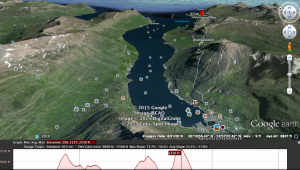 he issue of improving internet at Skalanes I did some research into the topography between the Skalanes lodge and the ferry station where the internet antenna is. I used google earth to draw a line from the ferry station to the lodge. It turns out that the are some mountains over 2,000ft in between which could be a large
he issue of improving internet at Skalanes I did some research into the topography between the Skalanes lodge and the ferry station where the internet antenna is. I used google earth to draw a line from the ferry station to the lodge. It turns out that the are some mountains over 2,000ft in between which could be a large 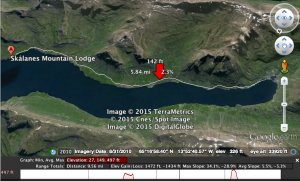 obstacle in the implementation of a balloon. Although the signal ‘curves’ it still seems like it would be hard to make the internet here more reliable this way. The screenshot on the left shows the topographic 3D map from the ferry station, looking down the fiord towards Skalanes.
obstacle in the implementation of a balloon. Although the signal ‘curves’ it still seems like it would be hard to make the internet here more reliable this way. The screenshot on the left shows the topographic 3D map from the ferry station, looking down the fiord towards Skalanes.
Next I looked for the telephone wire running to Skalanes which, I believe, is in the google earth image on the right.
A few more things about arctic terns:
average mass is 100g
105.63 F mean body temperature according to Body Temperatures of Antarctic Birds Carl R. Eklund (1942)
